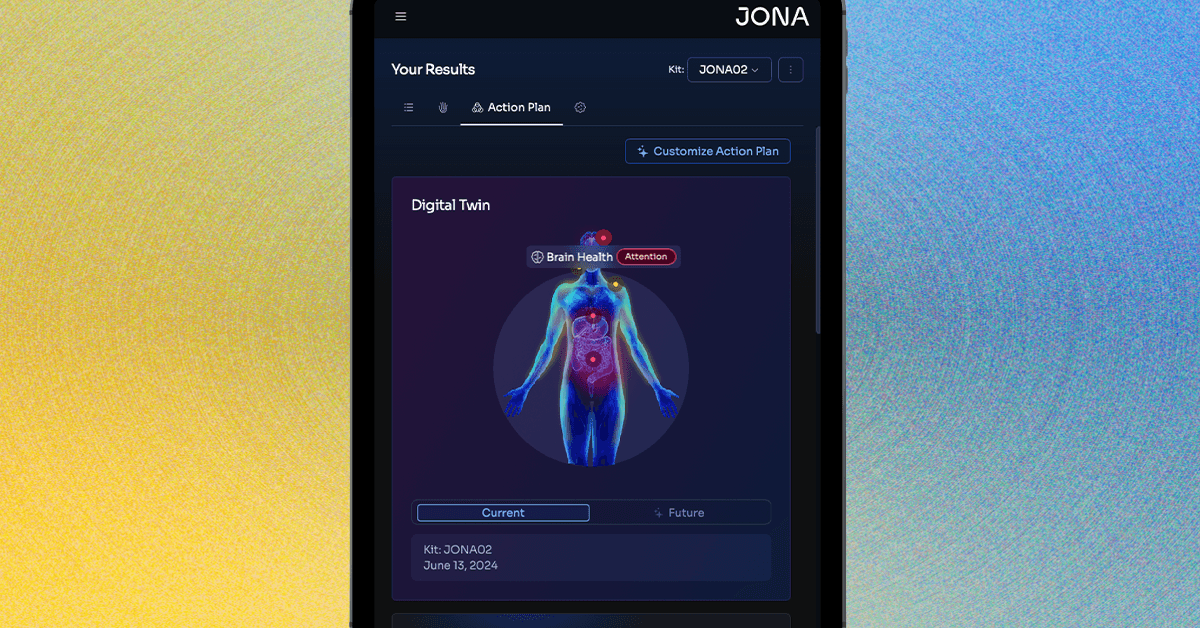Jona Health Review: Microbiome Decoder for Health Conditions

We hear a lot about the microbiome, often described as a zoo of different bacteria living in your digestive system. While some of these bacteria are beneficial, others can be harmful. Certain strains have been linked to longevity, whereas others are associated with serious diseases. In fact, virtually every aspect of our health—from cancer and mental health to diabetes—has some connection to the microbiome.
With thousands of companies eager for you to spend your paycheck on supplements that may or may not fit your specific needs, and thousands of new microbiome studies published each month, it’s nearly impossible for even the most dedicated gastroenterologist to keep up. This is where a new company, Jona Health, steps in.
### What is Jona Health?
Jona Health uses artificial intelligence (AI) to analyze the hundreds of bacterial strains in your gut. It cross-references these strains with the latest, highest-quality research to provide you with a personalized breakdown of your results. From there, you receive an action plan designed to theoretically improve your health outcomes. Unlike many products that shoehorn AI integration, Jona’s application genuinely makes sense.
—
### How It Works
To use Jona, you order a kit online. This kit is the same gold-standard test your gastroenterologist would provide, known as a shotgun test. It scans for every bacterial strain and also detects pathogens like parasites and viruses.
The kit is a home stool-sample kit. While the process may sound strange, it’s surprisingly easy to use. You collect your sample using a small paper hammock attached to your toilet seat, swab it, and then place the swab in a solution. The sample is then shipped to an independent lab with prepaid packaging. This lab sends the testing results directly to Jona Health.
After sending in your sample, you’ll receive results that include the relative abundance of hundreds of different bacteria found in your gut, something that would take years to research individually. Jona’s AI continuously reads new studies on the microbiome as they are published, ranking them by quality and applicability. For example, a large, longitudinal human study from a reputable institution might receive the highest rating, while small mouse or petri dish studies might score lower.
Within two to three weeks, you receive a detailed, interactive report highlighting any significant health associations and actionable recommendations. Links to the studies that informed the AI’s conclusions are included for transparency.
—
### No Conflicts of Interest
Importantly, Jona Health does not sell supplements or probiotics, nor does it recommend specific brands. This impartiality eliminates potential conflicts of interest common with other microbiome testing companies that push their own products. Jona’s sole offering is the test and analysis, making it a more trustworthy option.
—
### Getting Started: Intake and Sample Collection
When you first purchase the kit, you complete an intake form covering your diet, lifestyle, exercise habits, family medical history, and any symptoms or conditions you or your doctor are monitoring. Have you been experiencing excessive gas, fatigue, ADHD symptoms, or been told you’re prediabetic? Enter it all here. These details help Jona’s AI focus the analysis on relevant health areas.
My kit arrived in about three days. Admittedly, starting your day by collecting stool samples can feel like a mental hurdle, but the process itself was straightforward. After collecting and packaging the sample, I sent it off and waited for the results.
—
### Navigating Your Results
About twenty days later, I received an email indicating my results were ready. On the Jona website, results are divided into several sections:
– **Summary:** Covers Brain Health, GI Health, Metabolic Health, Skin Health, and Physical Performance.
– **Action Plan:** Subdivided into Highest Impact, Diet, Lifestyle, and Probiotics recommendations.
– **Organisms:** Lists every organism found in your sample and their relative abundance.
My results held several surprises. My Microbiome Diversity score was 4.19, which is above average (normal range: 2.80–3.99, measured by the Shannon Index). This score is a positive sign of a healthy microbiome. No pathogens or parasites were detected, and I was found to digest lactose well.
It also showed no significant associations with conditions like depression, celiac disease, IBS, ulcerative colitis, leaky gut, hypertension, or eczema, which was reassuring. Some expected results were confirmed, while others were unexpected.
For example, under Brain Health, there was a moderate association with stress and a low association with ADHD—both aligned with my experiences. In Metabolic Health, I had a “very low” association for prediabetes, whereas I anticipated a higher risk. Interestingly, I had a moderate association with osteoarthritis, which matches my family history.
—
### Unexpected Findings
One surprising result was a moderate association with Hashimoto’s disease, an autoimmune thyroid condition I had not considered. Checking my recent bloodwork showed normal thyroid levels, but a follow-up test revealed my thyroglobulin antibodies were nearly twice the normal range. This led me to consult an endocrinologist, who advised monitoring the thyroid closely. Without this test, I might not have caught this early.
Conversely, the test showed a moderate association with alopecia areata, an autoimmune disease causing hair loss, which I do not have. This highlights an important caveat: microbiome associations do not guarantee disease presence or causation.
—
### When Results Don’t Match Symptoms
Though I reported bloating on the intake form, the results showed no microbiome associations with this problem. I asked Jona’s team about this, and they explained that while the issue exists, there’s no current evidence linking it directly to the microbiome in my case. This discrepancy was slightly disappointing because I had hoped for clear insights or solutions.
—
### Recommendations and Action Plan
For each condition flagged, Jona provides top recommendations. For Hashimoto’s, these included increasing omega-3 fatty acids and magnesium intake (based on strong research) and upping my step count (based on more limited evidence). You can view the specific organisms related to each condition and access the studies backing the advice.
The Action Plan page breaks suggestions into Diet, Lifestyle, and Probiotics, along with a Highest Impact tab that narrows priorities to a few key actions. For me, these were increasing aerobic exercise and vitamins C, D, B2, plus magnesium—simple and manageable changes. This prioritization helped reduce feeling overwhelmed.
The platform even generates a downloadable grocery list tailored to its dietary recommendations, which I found very practical.
—
### Some Confusing Recommendations
Not all suggestions were straightforward. For instance, Jona advised avoiding the probiotic strain *Lacticaseibacillus paracasei* Shirota for Hashimoto’s, but recommended increasing it for prediabetes. It also advised consuming more arabinoxylan—a starch found in certain cereal grains like oats, barley, and rye bread—but strangely recommended avoiding rye itself. Questions like these prompted me to speak with Jona’s Chief Medical Officer, Dr. Lawrence Kosinski.
—
### Expert Insights
Dr. Kosinski likened the gut microbiome to different petri dishes that require the right nutrition to grow certain bacteria. His main takeaway: *Prebiotics are more important than probiotics.* What you eat shapes your microbiome more than supplements do, which is why Jona emphasizes dietary recommendations.
He also encouraged maintaining a diverse diet, which aligned with my current habits, though I was advised to integrate more of the recommended foods.
—
### My Follow-Up Test: Tracking Progress
Four months after implementing Jona’s recommendations—exercising more, managing stress better, and adjusting my diet—I retook the test. Dr. Kosinski noted my gut health had improved even more, despite a slight drop in my diversity score from 4.19 to 4.0. Many beneficial bacteria increased significantly.
Notably, my stress association dropped from moderate to very low, and prediabetes associations went from very low to none.
—
### Unexpected Fluctuations
However, other results were less encouraging. My Parkinson’s disease association rose from very low to moderate, which was unsettling. My alopecia areata risk jumped from moderate to high, again puzzling since I have no symptoms.
Reviewing the data, we found the bacterium *Akkermansia* had surged from 0.73% to 5.35%, well above the normal range (0.12–1.96%). Research suggests that excessive vitamin D intake could promote such an increase, indicating my daily supplement might have been too high. Dr. Kosinski reminded me again that food-based nutrients are generally preferable to supplementation.
—
### The Reality of a Dynamic Microbiome
These fluctuations illustrate the ever-changing nature of the microbiome. Each time I modified one aspect, another shifted unexpectedly—like playing whack-a-mole inside my gut. Consequently, my High Impact recommendations changed entirely with the second test.
Despite some frustrating surprises, I am grateful to have new health concerns on my radar, encouraging me to maintain a healthier lifestyle and keep my medical providers informed.
—
### New Features: Digital Twin and Track Changes
Since my tests, Jona has launched new tools. One is the **Digital Twin**, which creates a virtual replica of your microbiome to simulate how different actions might affect it. For example, it can focus on specific conditions (like Hashimoto’s and Parkinson’s) and display how targeted interventions could shift bacterial populations.
Another feature, launching by the end of 2025, will be a **Track Changes page** to visually overlay multiple test results, making it easier to spot trends and progress over time.
—
### Cost and Value Considerations
Jona’s test costs $485, which is higher than many competitor tests priced between $200 and $300. Those cheaper tests often analyze dozens of bacterial types and push supplements they sell. In contrast, Jona’s shotgun sequencing looks at tens of thousands of organisms through deep DNA sequencing, representing the medical gold standard.
Jona’s AI has digested over 220,000 microbiome-related studies and continues to update your results as new research emerges. While this test is not for everyone, it is a robust tool for those seeking in-depth insight into their gut health.
—
### Final Thoughts
It’s best to share your Jona results with your healthcare provider or a gastroenterologist for proper interpretation.
For me, this test provided valuable insight into one of the most complex systems in my body and offered guidance on improving my health. While an abundance of information can sometimes fuel anxiety, early detection can be crucial for managing certain diseases.
Overall, I’m glad I took the test—and I would absolutely do it again.
—
**If you’re curious about your microbiome and want a data-driven, unbiased analysis, Jona Health offers a compelling option worth considering.**
https://www.wired.com/review/jona-microbiome-test/








